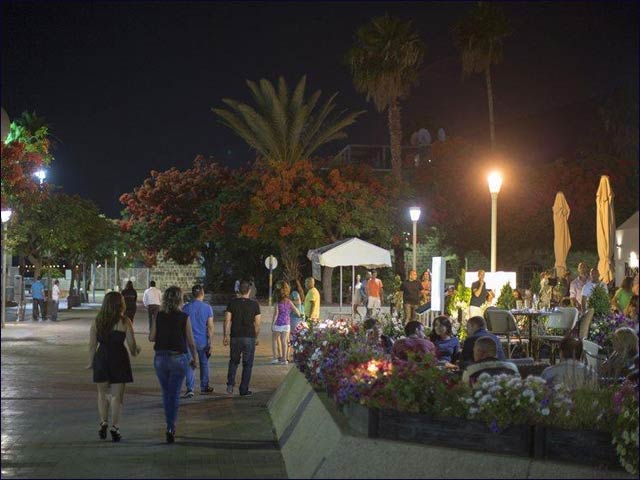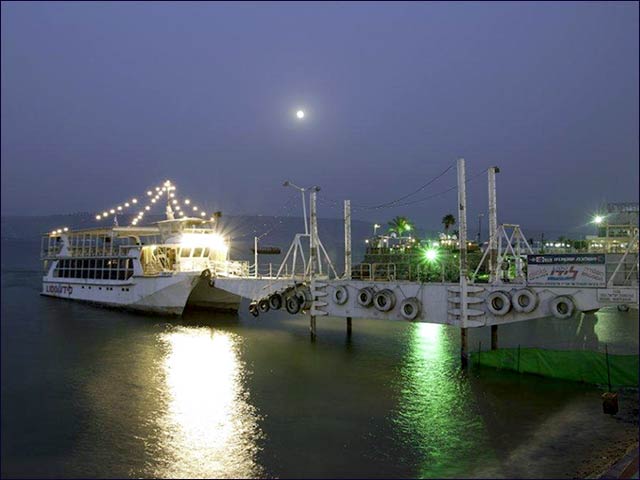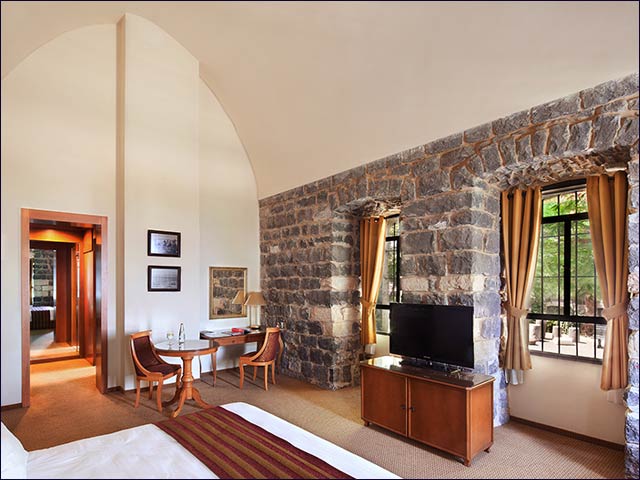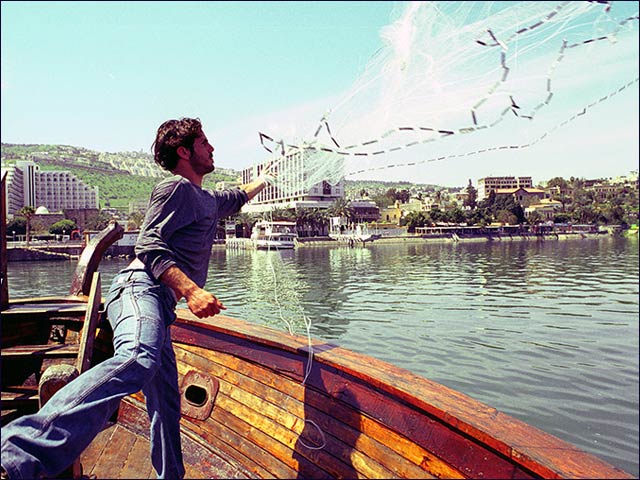By Avigayil Kadesh
Offering everything from religious pilgrimage sites and archeology to fine dining and water sports, the city of Tiberias on the Sea of Galilee (Lake Kinneret) is not only Israel’s lowest city at 200 meters below sea level, but it is also a destination for thousands of tourists every year.
Tiberias was established around 20 CE by Galilee Governor Herod Antipater, who named it after his patron, the Roman Emperor Tiberius. The city has been continuously inhabited ever since, in large part because the Kinneret is a source of both water and income from fishing.
During the second through tenth centuries, Tiberias was the largest and most prominent Jewish city in the Galilee and was also significant in the development of Christianity. That’s why many of the oldest churches in the world are found in Tiberias and in the surrounding lakeside towns.
We asked Tiberias Hotel Association CEO Joanne Smadar, an American immigrant, to pinpoint three of the most popular activities in the city for visitors.
“We have something for every faith and every kind of person who’s coming,” she replies. “Number one for all visitors is Tiberium, the new water show,” Smadar replied. “It speaks to everyone and it’s free of charge, running every day of the year except Yom Kippur.” You can read more about Tiberium below.
“For Christians, the Galilee Experience at the marina, a 36-minute show, is a chance to put all the Christian sites in Tiberias together in context,” she continues. “During Islamic holy days, Muslims come here by the thousands to take boat rides and enjoy the restaurants.
“For Jewish visitors, there are the tombs of the sages Rabbi Akiva, Rabbi Yochanan Ben-Zakai, Rabbi Meir Baal HaNess, and the great philosopher and sage Maimonides.” There is a new Maimonides Heritage Center at the tomb.
Smadar stresses that everyone, regardless of religion or nationality, enjoys boating in the Kinneret and strolling along the Yigal Alon Harbor promenade, where you can check how the lake’s water level is faring via a 16-foot-tall, 3D environmental sculpture.
 The Yigal Alon Harbor Promenade. Photo by Itamar Grinberg
The Yigal Alon Harbor Promenade. Photo by Itamar Grinberg As a top tourism city, Tiberias is easy for English-speakers to navigate. Signs are generally multilingual, and most of the local residents speak English.
Tiberium, dining out
The multimedia water show that Smadar so highly recommends is located on the southern end of the promenade. Every night at 7, 8 and 9 o’clock, a program of four different 15-minute shows begins, projected onto two high-tech water screens rising above the lake and accompanied by dozens of water jets, music, pyrotechnics, holograms, artistic lighting and other special effects.
Smadar says if you don’t feel like standing, you can watch the whole show while dining at one of two newly opened dairy restaurants, Basil and Rosa, on the promenade directly across from the show.
Tiberias has many well-known restaurants. Just to name a few, there are Mediterranean-style Avi Batan, the Argentinean grill Decks, and next door to Decks on the waterfront, Pagoda for kosher Chinese cuisine. Little Tiberias, which is not kosher, is a French Mediterranean chef restaurant inside a building that forms part of Roman-era city wall. Smadar says Little Tiberias is known for its “amazing steak” and it’s also pet-friendly.
In the marina area, many cafes and restaurants specialize in preparing fresh fish from the Kinneret. The fishing industry goes back to the Stone Age in Tiberias, and you’ll still see fishing boats heading out every morning for the day’s catch.
The Kinneret Sailing Company offers a one-hour expedition on Fridays, where passengers watch a net-fishing crew at work and learn about the history of fishing in the Sea of Galilee. The same company also offers a four-hour “Fisherman for a Day” cruise for up to seven people.
If you prefer your water without the fish, you can rent a canoe or book a day or nighttime cruise at various places along the promenade. Kite-surfing, windsurfing and kayaking are also popular activities at the harbor.

The Tiberias marina at night. Photo courtesy of Israel Tourism Ministry Beaches and archeology
Many of the 29 Tiberias Hotel Association member hotels (which do not include numerous bed-and-breakfast inns as well as youth hostels) are situated on the waterfront and have their own beaches reserved for guests. The city also offers public beaches that charge per carload.
The Shaldag and Holiday Inn beaches boast pub-restaurants, water sports and children’s playgrounds, while Gai Beach Aquatic Park offers water slides, a swimming pool and a wave pool.
Massages, mud treatments and Turkish baths are available at Tiberias Hot Springs , a series of ancient pools fed by 17 natural mineral-rich springs originating at nearby Hamat Tiberias National Park. The spa has indoor and outdoor thermo-mineral pools, a hot tub, heated swimming pool, private beach, saunas and gym.
A new large hotel will start construction on the Tiberias waterfront this year, according to Smadar.
“During high season, from mid-February to the end of May, and again around mid-September to the end of November, it can be difficult to get rooms here because of tourists from all over world, and during Jewish holidays the hotels are all full of Israelis on vacation,” says Smadar, commenting on the need for the new facility.
Several Tiberias hotels offer special tours and boat rides for guests. And every Saturday at 10:30 in the morning, the hotel association runs a free walking tour for those staying at member hotels.
The route starts at the small archaeological park housing the association’s offices, where you can explore the ruins of a sixth-century synagogue -- one of 13 synagogues that stood in Tiberias during Talmudic times – and a Crusader-Ottoman building constructed in the 12th century. The guide then proceeds toward the promenade through the synagogue begun by Rabbi Haim Abulafia, who died in 1744 in Tiberias. The tour continues past the Old City walls, the Church of St. Peter and the former Scottish hospital that is now a boutique hotel.

The boutique Scots Hotel used to be a hospital The tour ends at the Doña Gracia House Museum and hotel, devoted to Gracia Mendes Nasi, one of the most influential Jewish women of Renaissance Europe. She used her wealth to provide escape routes for many Jewish refugees of the Spanish Inquisition. Her most ambitious scheme involved leasing the Tiberias region in 1558 from the Ottoman ruler Suleiman the Magnificent, to house some of the refugees and reestablish Tiberias as a Jewish center of settlement. She never got to live there herself, but the castle she commissioned tells her story today in a multimedia experience.
At the southern entrance to the city is the 25-acre Berko Archeological Park, developed in 2008 by the Antiquities Authority in memory of longtime Tiberias community leader Ozer Berkowitz. According to Smadar, it’s not just a major archeological site – it is thought that here the Jewish Sanhedrin once sat – but also a seven-day-a-week family adventure park offering archeological digs, summer concerts, rope pyramids, Omega zip line, climbing wall, swings and carousels.

Demonstration of ancient fishing techniques on the Sea of Galilee
Photo courtesy of Israel Tourism Ministry Visitors enter Berko Park through a recently unearthed 2,000-year-old gate leading to the remains of the Roman Cardo, or marketplace, marked with columns and capitols. There are remains of a Roman bathhouse and a Byzantine city wall, agricultural installations and an open-air arena that once sat up to 7,000 spectators.
The Old City area of Tiberias was built up during the Crusades (11th century to 13th century) and the period of the Ottoman Empire rule (16th century to 19th century) over the Holy Land.
The Church of St. Peter is the most visited church in this area, constructed on the ruins of a Crusader-era church that was designed to resemble the hull of an overturned boat. The modern church displays artwork and stained-glass windows symbolizing the four Gospels and depicting fish and Church founders. Outside, a replica of a statue of St. Peter brought to Tiberias from Rome in 1833 stands in the courtyard.
If you time your visit right, you might catch a concert at the basalt-stone Church of Scotland, founded in the 19th century just outside the Old City, along with the city’s first hospital, by Dr. David Watt Torrance. Across the street from the church is the former hospital, now the luxury Scots Hotel popular with Christian pilgrims. Still owned by the Church of Scotland, the hotel encompasses 50 regular rooms and 19 antique renovated rooms, a swimming pool, spa treatments, gourmet restaurant, Scottish bar, antique wine cellar, herb garden and archeological tours.
At the southern end of the Yigal Alon Harbor promenade is a Greek Orthodox church and monastery. Nearby Mount Berenice (alternatively, Mount Berniki) contains the ruins of the Byzantine-era Anchor Church, which got its name from the ancient anchor found at the center of the stone altar. The mountain also affords a panoramic view over Tiberias.
Thousands of white-robed Christian pilgrims journey just south of Tiberias to Yardenit, where the Jordan River flows from the Sea of Galilee to the Dead Sea. Yardenit is the site traditionally recognized as the place where John the Baptist baptized Jesus.
Yardenit is open daily free of charge. Kibbutz Kinneret hosts a Visitors Center where pilgrims can rent or buy a white robe, shop for souvenirs, eat, shower and change. Several baptismal pools can be reached by following the Wall of New Life created by an Armenian artist from Jerusalem, which depicts the account from the Gospel of Mark (1:9-11) about the original baptism.